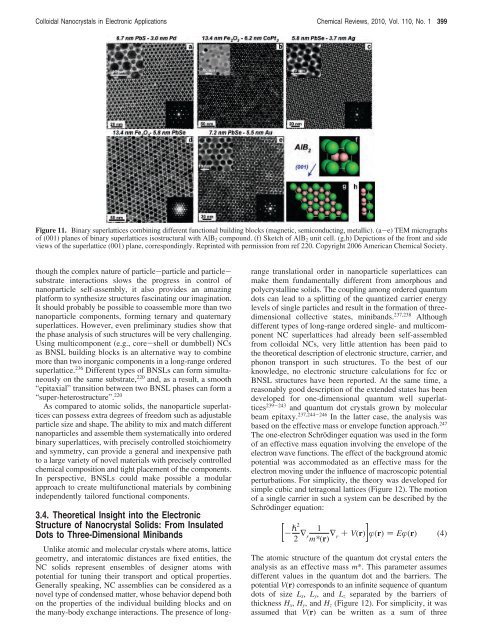Prospects of Colloidal Nanocrystals for Electronic - Computer Science
Prospects of Colloidal Nanocrystals for Electronic - Computer Science
Prospects of Colloidal Nanocrystals for Electronic - Computer Science
Create successful ePaper yourself
Turn your PDF publications into a flip-book with our unique Google optimized e-Paper software.
<strong>Colloidal</strong> <strong>Nanocrystals</strong> in <strong>Electronic</strong> Applications Chemical Reviews, 2010, Vol. 110, No. 1 399<br />
Figure 11. Binary superlattices combining different functional building blocks (magnetic, semiconducting, metallic). (a-e) TEM micrographs<br />
<strong>of</strong> (001) planes <strong>of</strong> binary superlattices isostructural with AlB2 compound. (f) Sketch <strong>of</strong> AlB2 unit cell. (g,h) Depictions <strong>of</strong> the front and side<br />
views <strong>of</strong> the superlattice (001) plane, correspondingly. Reprinted with permission from ref 220. Copyright 2006 American Chemical Society.<br />
though the complex nature <strong>of</strong> particle-particle and particlesubstrate<br />
interactions slows the progress in control <strong>of</strong><br />
nanoparticle self-assembly, it also provides an amazing<br />
plat<strong>for</strong>m to synthesize structures fascinating our imagination.<br />
It should probably be possible to coassemble more than two<br />
nanoparticle components, <strong>for</strong>ming ternary and quaternary<br />
superlattices. However, even preliminary studies show that<br />
the phase analysis <strong>of</strong> such structures will be very challenging.<br />
Using multicomponent (e.g., core-shell or dumbbell) NCs<br />
as BNSL building blocks is an alternative way to combine<br />
more than two inorganic components in a long-range ordered<br />
superlattice. 236 Different types <strong>of</strong> BNSLs can <strong>for</strong>m simultaneously<br />
on the same substrate, 220 and, as a result, a smooth<br />
“epitaxial” transition between two BNSL phases can <strong>for</strong>m a<br />
“super-heterostructure”. 220<br />
As compared to atomic solids, the nanoparticle superlattices<br />
can possess extra degrees <strong>of</strong> freedom such as adjustable<br />
particle size and shape. The ability to mix and match different<br />
nanoparticles and assemble them systematically into ordered<br />
binary superlattices, with precisely controlled stoichiometry<br />
and symmetry, can provide a general and inexpensive path<br />
to a large variety <strong>of</strong> novel materials with precisely controlled<br />
chemical composition and tight placement <strong>of</strong> the components.<br />
In perspective, BNSLs could make possible a modular<br />
approach to create multifunctional materials by combining<br />
independently tailored functional components.<br />
3.4. Theoretical Insight into the <strong>Electronic</strong><br />
Structure <strong>of</strong> Nanocrystal Solids: From Insulated<br />
Dots to Three-Dimensional Minibands<br />
Unlike atomic and molecular crystals where atoms, lattice<br />
geometry, and interatomic distances are fixed entities, the<br />
NC solids represent ensembles <strong>of</strong> designer atoms with<br />
potential <strong>for</strong> tuning their transport and optical properties.<br />
Generally speaking, NC assemblies can be considered as a<br />
novel type <strong>of</strong> condensed matter, whose behavior depend both<br />
on the properties <strong>of</strong> the individual building blocks and on<br />
the many-body exchange interactions. The presence <strong>of</strong> long-<br />
range translational order in nanoparticle superlattices can<br />
make them fundamentally different from amorphous and<br />
polycrystalline solids. The coupling among ordered quantum<br />
dots can lead to a splitting <strong>of</strong> the quantized carrier energy<br />
levels <strong>of</strong> single particles and result in the <strong>for</strong>mation <strong>of</strong> threedimensional<br />
collective states, minibands. 237,238 Although<br />
different types <strong>of</strong> long-range ordered single- and multicomponent<br />
NC superlattices had already been self-assembled<br />
from colloidal NCs, very little attention has been paid to<br />
the theoretical description <strong>of</strong> electronic structure, carrier, and<br />
phonon transport in such structures. To the best <strong>of</strong> our<br />
knowledge, no electronic structure calculations <strong>for</strong> fcc or<br />
BNSL structures have been reported. At the same time, a<br />
reasonably good description <strong>of</strong> the extended states has been<br />
developed <strong>for</strong> one-dimensional quantum well superlattices239-243<br />
and quantum dot crystals grown by molecular<br />
beam epitaxy. 237,244-246 In the latter case, the analysis was<br />
based on the effective mass or envelope function approach. 247<br />
The one-electron Schrödinger equation was used in the <strong>for</strong>m<br />
<strong>of</strong> an effective mass equation involving the envelope <strong>of</strong> the<br />
electron wave functions. The effect <strong>of</strong> the background atomic<br />
potential was accommodated as an effective mass <strong>for</strong> the<br />
electron moving under the influence <strong>of</strong> macroscopic potential<br />
perturbations. For simplicity, the theory was developed <strong>for</strong><br />
simple cubic and tetragonal lattices (Figure 12). The motion<br />
<strong>of</strong> a single carrier in such a system can be described by the<br />
Schrödinger equation:<br />
[ -p2<br />
2 ∇ 1<br />
rm*(r)<br />
∇r + V(r)] �(r) ) E�(r) (4)<br />
The atomic structure <strong>of</strong> the quantum dot crystal enters the<br />
analysis as an effective mass m*. This parameter assumes<br />
different values in the quantum dot and the barriers. The<br />
potential V(r) corresponds to an infinite sequence <strong>of</strong> quantum<br />
dots <strong>of</strong> size Lx, Ly, and Lz separated by the barriers <strong>of</strong><br />
thickness Hx, Hy, and Hz (Figure 12). For simplicity, it was<br />
assumed that V(r) can be written as a sum <strong>of</strong> three
















